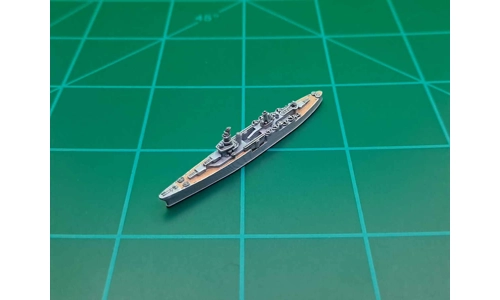
Portland Class Heavy Cruiser
Product Details
- Portland Class Heavy Cruiser
- CA-PORTLAND-EM-P
-
- Units in Stock: 4
Portland Class Heavy Cruiser Summary
This is the 3D print sculpt of the USS Portland by EBard Models.The Portland class of heavy cruisers was ordered in 1930. The class was originally designated as a light cruiser, and re-designated as a heavy cruiser due to their armament, in accordance with the London Naval Treaty. Originally, eight cruisers were envisioned as modified Northampton-class vessels, but eventually two of these became the Portland class, with the remaining six eventually being further modified into the succeeding New Orleans class. The first three New Orleans-class cruisers, New Orleans, Astoria, and Minneapolis, were initially ordered as Portland-class vessels, but were reordered to the design of USS Tuscaloosa (CA-37).
The Portland class was the third class of heavy cruiser to be constructed by the United States Navy following the Washington Naval Treaty of 1922. The first "treaty cruisers" were the two of the Pensacola class, which emphasized armament and speed at the expense of protection. These ships were followed by the six vessels of the Northampton class with slightly better armor, and introduced the configuration of three triple turrets which would become standard on U.S. Navy heavy cruisers. The Portland class was a mix of both the Pensacola and Northampton designs and look similar to the Northampton class.
The Portland class displaced just under 10,000 long tons (10,000 t) and featured heavier armor and armament than previous cruisers. Featuring 8"/55 caliber guns and designed to function as fleet flagships, the Portland class were intended to fix problems with armament and armor that had been a weakness of preceding U.S. cruisers.
The class's main guns were the first to be specially designed to fire long-point projectiles with a streamlined shape, which increased the guns' range when compared with older cruiser guns. Such projectiles were in use by ships of the Imperial Japanese Navy, which until that point out-ranged U.S. cruisers with their firepower. The New Orleans class was designed with these lessons in mind, intended to create a better balance between protection, armament and speed.
The class also featured an aircraft catapult amidships and could carry four aircraft.
While the Portland-class cruisers were more heavily armored than preceding classes, protection was still considered inadequate and a new design was called for, which became the New Orleans class.
The two ships of the class, Portland and Indianapolis, saw extensive service during the Pacific War in World War II.
Portland served in many engagements including the Battle of Coral Sea, the Battle of Midway and the Guadalcanal Campaign, where she was severely damaged but nonetheless able to return to service. She later fought in the Battle of Leyte Gulf and the Battle of Okinawa. Indianapolis served as a fleet flagship for much of the war and fought in the Battle of Philippine Sea and the Battle of Iwo Jima. On 30 July 1945, after transporting components for the nuclear weapons Little Boy and Fat Man from the United States, she was torpedoed by the Japanese submarine I-58. Due to a series of errors and miscommunications her loss was not discovered for several days, and only 316 of her 1,195 crew survived – the greatest single loss of life at sea, from a single ship, in the history of the U.S. Navy.
By 1945, the anti-aircraft defenses of both ships had repeatedly been upgraded, with each eventually receiving twenty four Bofors 40 mm guns. On Portland these were arranged in four quad mounts and four twin mounts, and on Indianapolis they were arrayed in six quad mounts. Both ships were also upgraded with twelve Oerlikon 20 mm cannons
Ships of Class:
- CA-33 Portland - Survived the war, sold for scrap, 1959
- CA-35 Indianapolis - Torpedoed and sunk on 30 July 1945 by Japanese submarine I-58
| Early War | Mid War | ETO |
 |
 |
 |
Customer Reviews
No Reviews Posted Yet - be the first!
(write review)
